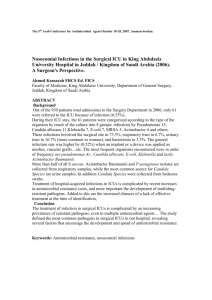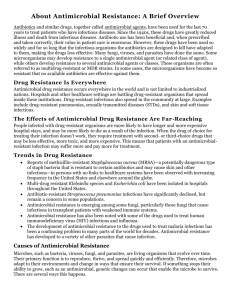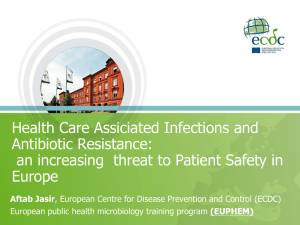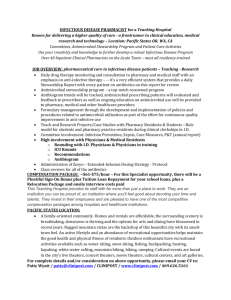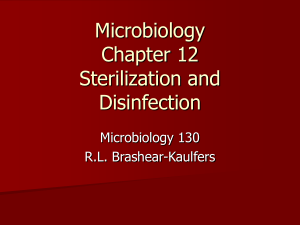WHO 2015
advertisement
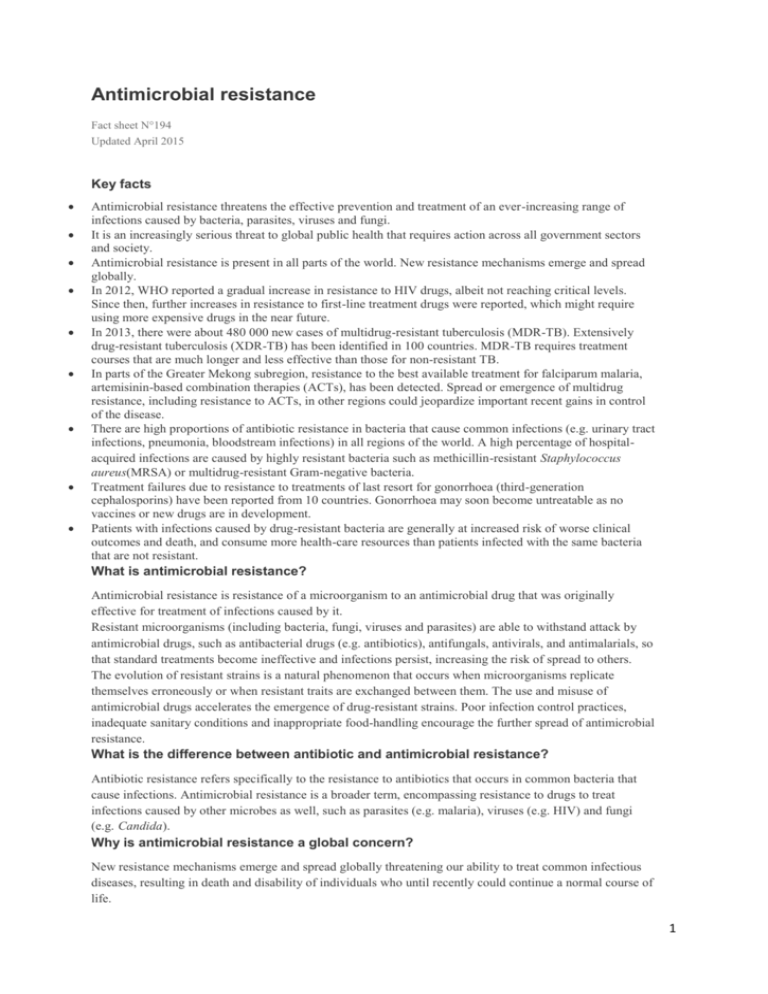
Antimicrobial resistance Fact sheet N°194 Updated April 2015 Key facts Antimicrobial resistance threatens the effective prevention and treatment of an ever-increasing range of infections caused by bacteria, parasites, viruses and fungi. It is an increasingly serious threat to global public health that requires action across all government sectors and society. Antimicrobial resistance is present in all parts of the world. New resistance mechanisms emerge and spread globally. In 2012, WHO reported a gradual increase in resistance to HIV drugs, albeit not reaching critical levels. Since then, further increases in resistance to first-line treatment drugs were reported, which might require using more expensive drugs in the near future. In 2013, there were about 480 000 new cases of multidrug-resistant tuberculosis (MDR-TB). Extensively drug-resistant tuberculosis (XDR-TB) has been identified in 100 countries. MDR-TB requires treatment courses that are much longer and less effective than those for non-resistant TB. In parts of the Greater Mekong subregion, resistance to the best available treatment for falciparum malaria, artemisinin-based combination therapies (ACTs), has been detected. Spread or emergence of multidrug resistance, including resistance to ACTs, in other regions could jeopardize important recent gains in control of the disease. There are high proportions of antibiotic resistance in bacteria that cause common infections (e.g. urinary tract infections, pneumonia, bloodstream infections) in all regions of the world. A high percentage of hospitalacquired infections are caused by highly resistant bacteria such as methicillin-resistant Staphylococcus aureus(MRSA) or multidrug-resistant Gram-negative bacteria. Treatment failures due to resistance to treatments of last resort for gonorrhoea (third-generation cephalosporins) have been reported from 10 countries. Gonorrhoea may soon become untreatable as no vaccines or new drugs are in development. Patients with infections caused by drug-resistant bacteria are generally at increased risk of worse clinical outcomes and death, and consume more health-care resources than patients infected with the same bacteria that are not resistant. What is antimicrobial resistance? Antimicrobial resistance is resistance of a microorganism to an antimicrobial drug that was originally effective for treatment of infections caused by it. Resistant microorganisms (including bacteria, fungi, viruses and parasites) are able to withstand attack by antimicrobial drugs, such as antibacterial drugs (e.g. antibiotics), antifungals, antivirals, and antimalarials, so that standard treatments become ineffective and infections persist, increasing the risk of spread to others. The evolution of resistant strains is a natural phenomenon that occurs when microorganisms replicate themselves erroneously or when resistant traits are exchanged between them. The use and misuse of antimicrobial drugs accelerates the emergence of drug-resistant strains. Poor infection control practices, inadequate sanitary conditions and inappropriate food-handling encourage the further spread of antimicrobial resistance. What is the difference between antibiotic and antimicrobial resistance? Antibiotic resistance refers specifically to the resistance to antibiotics that occurs in common bacteria that cause infections. Antimicrobial resistance is a broader term, encompassing resistance to drugs to treat infections caused by other microbes as well, such as parasites (e.g. malaria), viruses (e.g. HIV) and fungi (e.g. Candida). Why is antimicrobial resistance a global concern? New resistance mechanisms emerge and spread globally threatening our ability to treat common infectious diseases, resulting in death and disability of individuals who until recently could continue a normal course of life. 1 Without effective anti-infective treatment, many standard medical treatments will fail or turn into very high risk procedures. Antimicrobial resistance kills Infections caused by resistant microorganisms often fail to respond to the standard treatment, resulting in prolonged illness, higher health care expenditures, and a greater risk of death. As an example, the death rate for patients with serious infections caused by common bacteria treated in hospitals can be about twice that of patients with infections caused by the same non-resistant bacteria. For example, people with MRSA (methicillin-resistant Staphylococcus aureus, another common source of severe infections in the community and in hospitals) are estimated to be 64% more likely to die than people with a non-resistant form of the infection. Antimicrobial resistance hampers the control of infectious diseases Antimicrobial resistance reduces the effectiveness of treatment; thus patients remain infectious for a longer time, increasing the risk of spreading resistant microorganisms to others. For example, the emergence of Plasmodium falciparummultidrug resistance, including resistance to ACTs in the Greater Mekong subregion is an urgent public health concern that is threatening global efforts to reduce the burden of malaria. Although MDR-TB is a growing concern, it is still largely under-reported, compromising control efforts. Antimicrobial resistance increases the costs of health care When infections become resistant to first-line drugs, more expensive therapies must be used. A longer duration of illness and treatment, often in hospitals, increases health care costs as well as the economic burden on families and societies. Antimicrobial resistance jeopardizes health care gains to society The achievements of modern medicine are put at risk by antimicrobial resistance. Without effective antimicrobials for prevention and treatment of infections, the success of organ transplantation, cancer chemotherapy and major surgery would be compromised. Present situation Resistance in bacteria WHO’s 2014 report on global surveillance of antimicrobial resistance revealed that antibiotic resistance is no longer a prediction for the future; it is happening right now, across the world, and is putting at risk the ability to treat common infections in the community and hospitals. Without urgent, coordinated action, the world is heading towards a post-antibiotic era, in which common infections and minor injuries, which have been treatable for decades, can once again kill. Treatment failure to the drug of last resort for gonorrhoea – third-generation cephalosporins – has been confirmed in several countries. Untreatable gonococcal infections result in increased rates of illness and complications, such as infertility, adverse pregnancy outcomes and neonatal blindness, and has the potential to reverse the gains made in the control of this sexually transmitted infection. Resistance to one of the most widely used antibacterial drugs for the oral treatment of urinary tract infections caused by E. coli – fluoroquinolones – is very widespread. Resistance to first-line drugs to treat infections caused by Staphlylococcus aureus – a common cause of severe infections acquired both in health-care facilities and in the community – is also widespread. Resistance to the treatment of last resort for life-threatening infections caused by common intestinal bacteria – carbapenem antibiotics – has spread to all regions of the world. Key tools to tackle antibiotic resistance – such as basic systems to track and monitor the problem – reveal considerable gaps. In many countries, they do not even seem to exist. Resistance in tuberculosis In 2013, there were an estimated 480 000 new cases of MDR-TB in the world. Globally, 3.5% of new TB cases and 20.5% of previously treated TB cases are estimated to have MDR-TB, with substantial differences in the frequency of MDR-TB among countries. Extensively drug-resistant TB (XDR-TB, defined as MDRTB plus resistance to any fluoroquinolone and any second-line injectable drug) has been identified in 100 countries, in all regions of the world. Percentage of new TB cases with multidrug-resistant tuberculosis 2 View graph Percentage of previously treated TB cases with multidrug-resistant tuberculosis View graph Resistance in malaria The emergence of P. falciparum multidrug resistance, including resistance to ACTs, in the Greater Mekong subregion is an urgent public health concern that is threatening the ongoing global effort to reduce the burden of malaria. Routine monitoring of therapeutic efficacy is essential to guide and adjust treatment policies. It can also help to detect early changes in P. falciparum sensitivity to antimalarial drugs. Resistance in HIV HIV drug resistance emerges when HIV replicates in the body of a person infected with the virus who is taking antiretroviral drugs. Even when antiretroviral therapy (ART) programmes are very well-managed, some degree of HIV drug resistance will emerge. Available data suggest that continued expansion of access to ART is associated with a rise in HIV drug resistance. In 2013, 12.9 million people living with HIV were receiving antiretroviral therapy globally, of which 11.7 million were in low- and middle-income countries. HIV drug resistance may rise to such a level that the first-line and second-line ART regimens currently used to treat HIV become ineffective, jeopardizing people’s lives and threatening national and global investments in ART programmes. As of 2010, levels of HIV drug resistance among adults who had not begun treatment in countries scaling up ART were found to be about 5% globally. However, since 2010, there are reports suggesting that pretreatment resistance is increasing, peaking at 22% in some areas. Continuous surveillance of HIV drug resistance is of paramount importance to inform global and national decisions on the selection of first and second-line ART and to maximize overall population level treatment effectiveness. Resistance in influenza Over the past 10 years, antiviral drugs have become important tools for treatment of epidemic and pandemic influenza. Several countries have developed national guidance on their use and have stockpiled the drugs for 3 pandemic preparedness. The constantly evolving nature of influenza means that resistance to antiviral drugs is continuously emerging. By 2012, virtually all influenza A viruses circulating in humans were resistant to drugs frequently used for the prevention of influenza (amantadine and rimantadine). However, the frequency of resistance to the neuraminidase inhibitor oseltamivir remains low (1-2%). Antiviral susceptibility is constantly monitored through the WHO Global Surveillance and Response System. What accelerates the emergence and spread of antimicrobial resistance? The development of antimicrobial resistance is a natural phenomenon. However, certain human actions accelerate its emergence and spread. The inappropriate use of antimicrobial drugs, including in animal husbandry, favours the emergence and selection of resistant strains, and poor infection prevention and control practices contribute to further emergence and spread of antimicrobial resistance. Need for concerted actions Antimicrobial resistance is a complex problem driven by many interconnected factors. As such, single, isolated interventions have little impact. Coordinated action is required to minimize emergence and spread of antimicrobial resistance. People can help tackle resistance by: hand washing, and avoiding close contact with sick people to prevent transmission of bacterial infections and viral infections such as influenza or rotavirus, and using condoms to prevent the transmission of sexuallytransmitted infections; getting vaccinated, and keeping vaccinations up to date; using antimicrobial drugs only when they are prescribed by a certified health professional; completing the full treatment course (which in the case of antiviral drugs may require life-long treatment), even if they feel better; never sharing antimicrobial drugs with others or using leftover prescriptions. Health workers and pharmacists can help tackle resistance by: enhancing infection prevention and control in hospitals and clinics; only prescribing and dispensing antibiotics when they are truly needed; prescribing and dispensing the right antimicrobial drugs to treat the illness. Policymakers can help tackle resistance by: improving monitoring around the extent and causes of resistance; strengthening infection control and prevention; regulating and promoting appropriate use of medicines; making information widely available on the impact of antimicrobial resistance and how the public and health professionals can play their part; rewarding innovation and development of new treatment options and other tools. Policymakers, scientists and industry can help tackle resistance by: fostering innovation and research and development of new vaccines, diagnostics, infection treatment options and other tools. WHO's response WHO is guiding the response to antimicrobial resistance by: bringing all stakeholders together to agree on and work towards a coordinated response; strengthening national stewardship and plans to tackle antimicrobial resistance; generating policy guidance and providing technical support for Member States; actively encouraging innovation, research and development. WHO is already working closely with the World Organisation for Animal Health (OIE) and the Food and Agriculture Organization of the United Nations (FAO) to promote best practices to avoid the emergence and spread of antibacterial resistance, including optimal use of antibiotics in both humans and animals. WHO has developed, a draft global action plan to combat antimicrobial resistance which has been submitted to the sixty-eighth World Health Assembly, taking place in May 2015. 4

